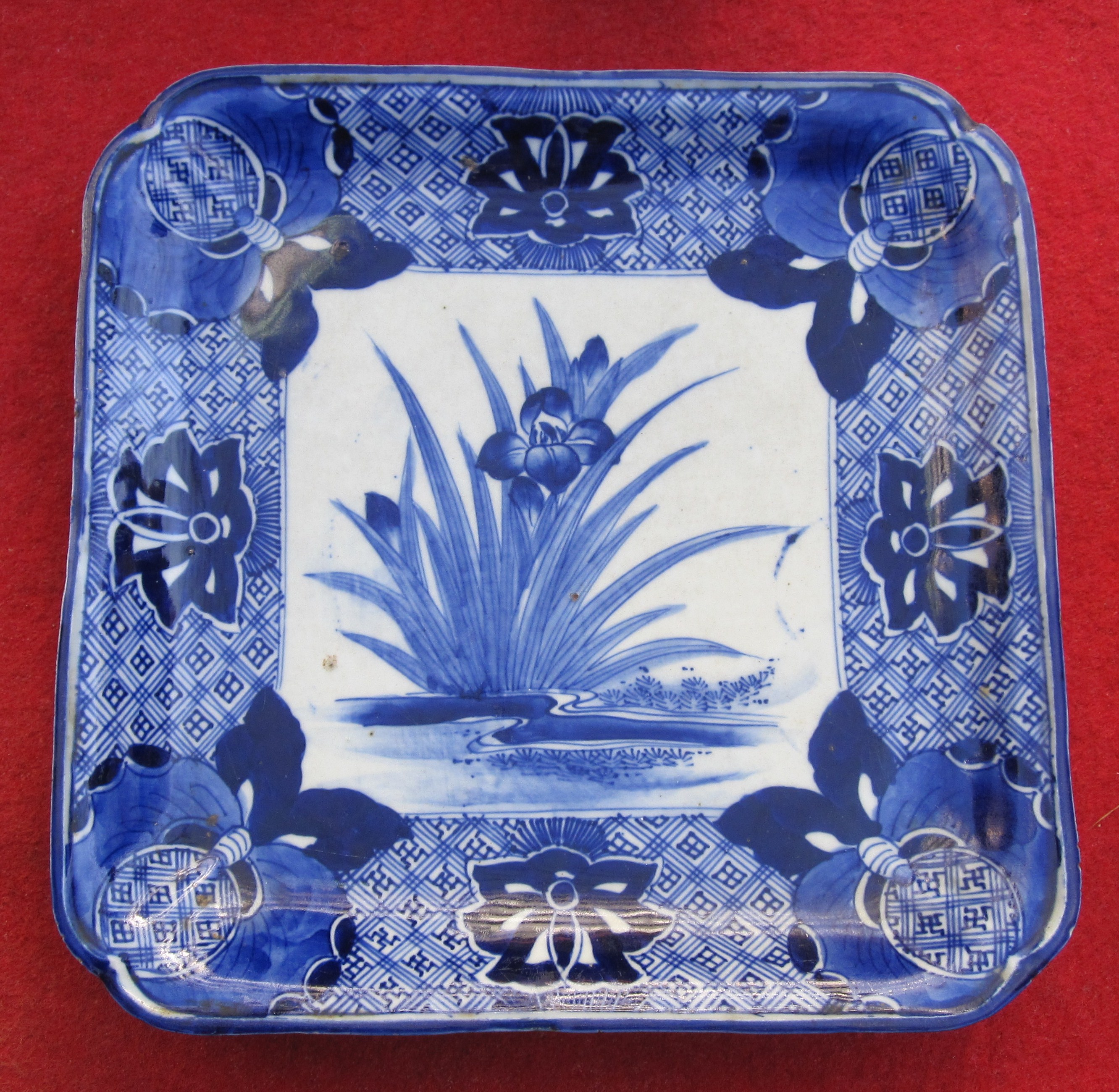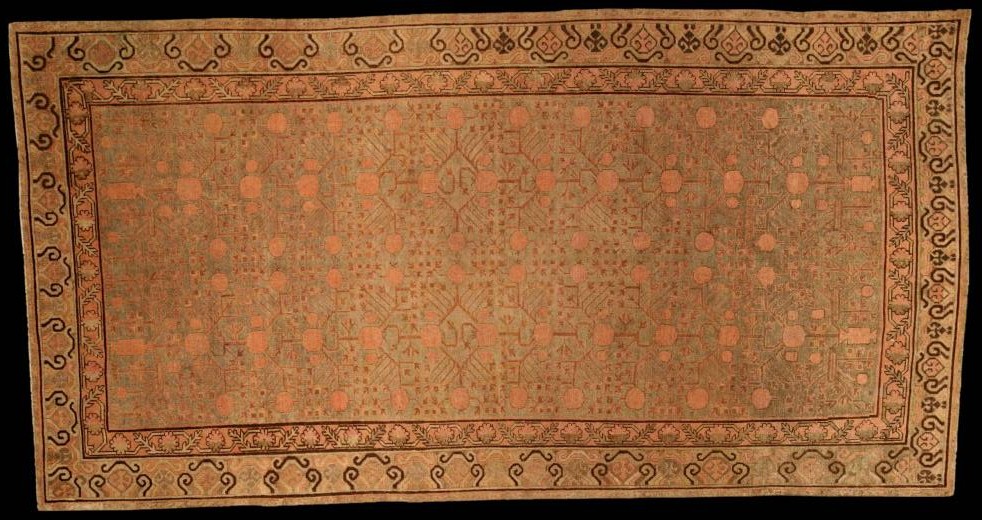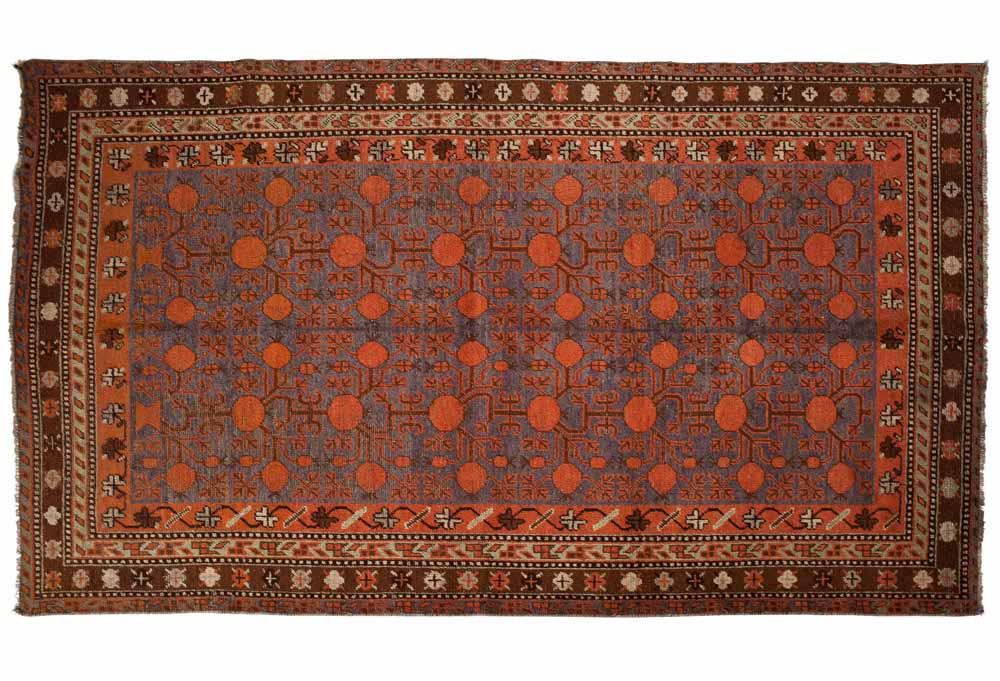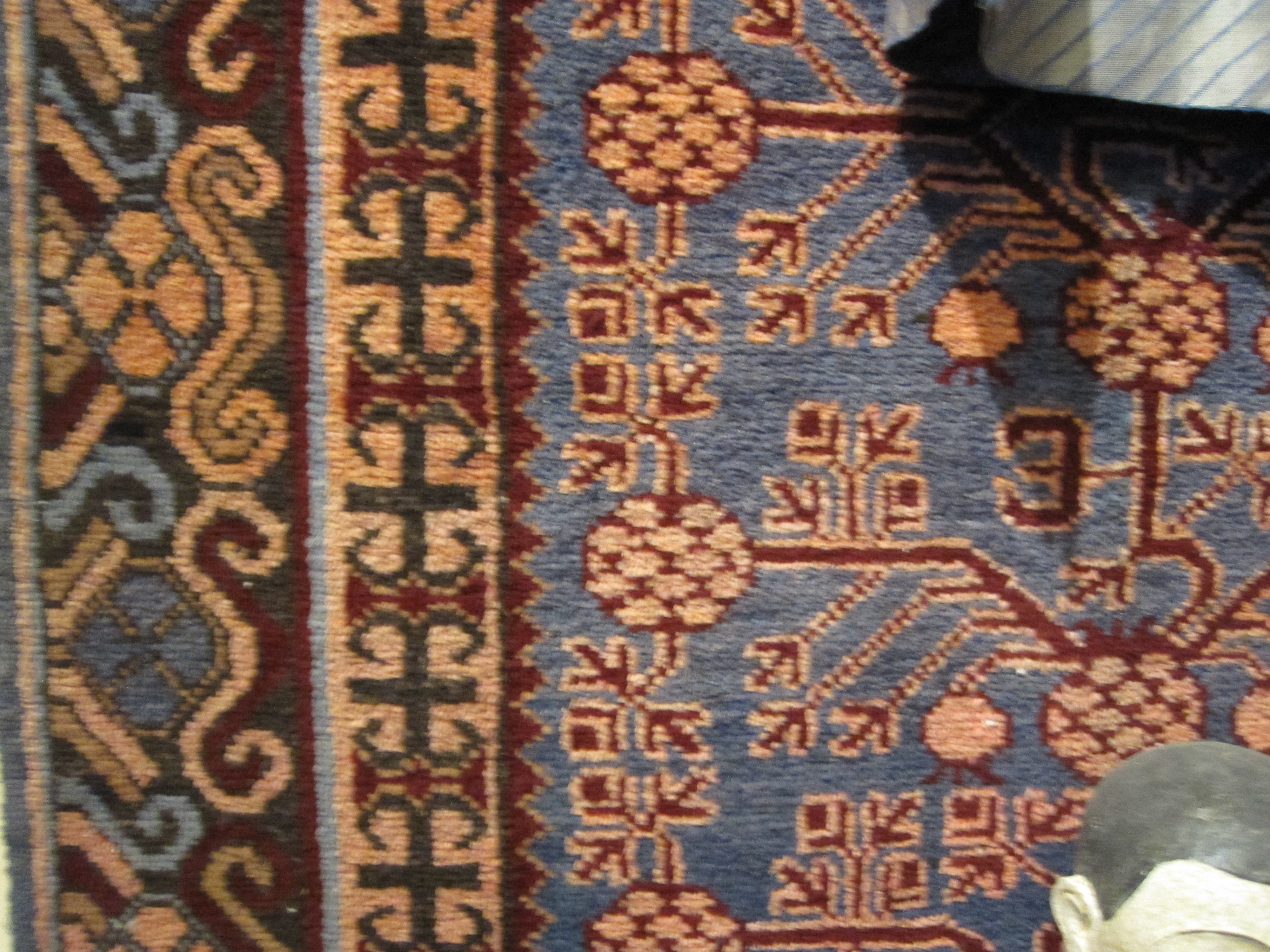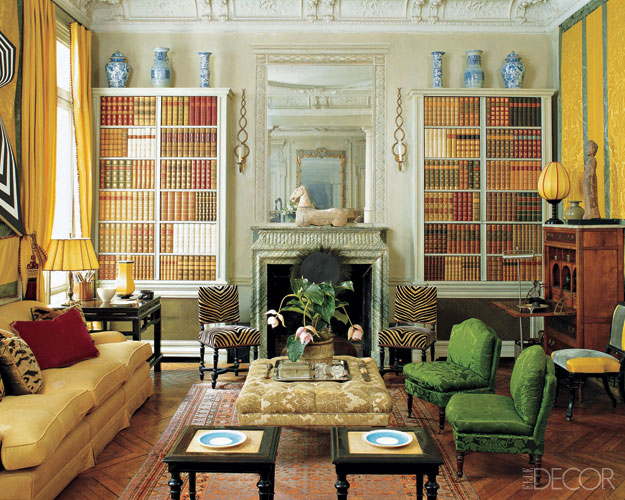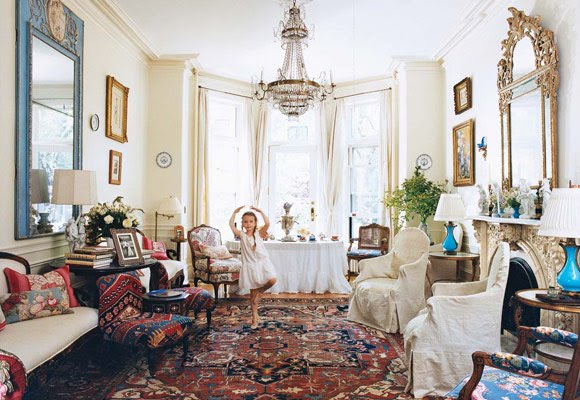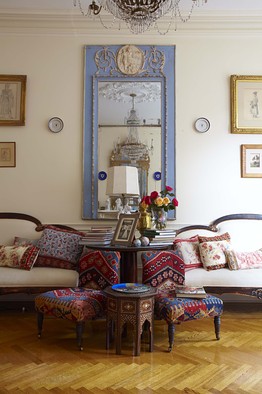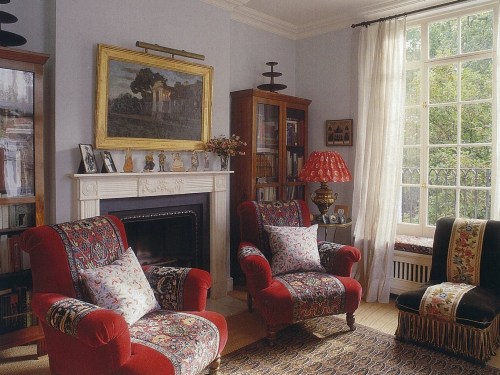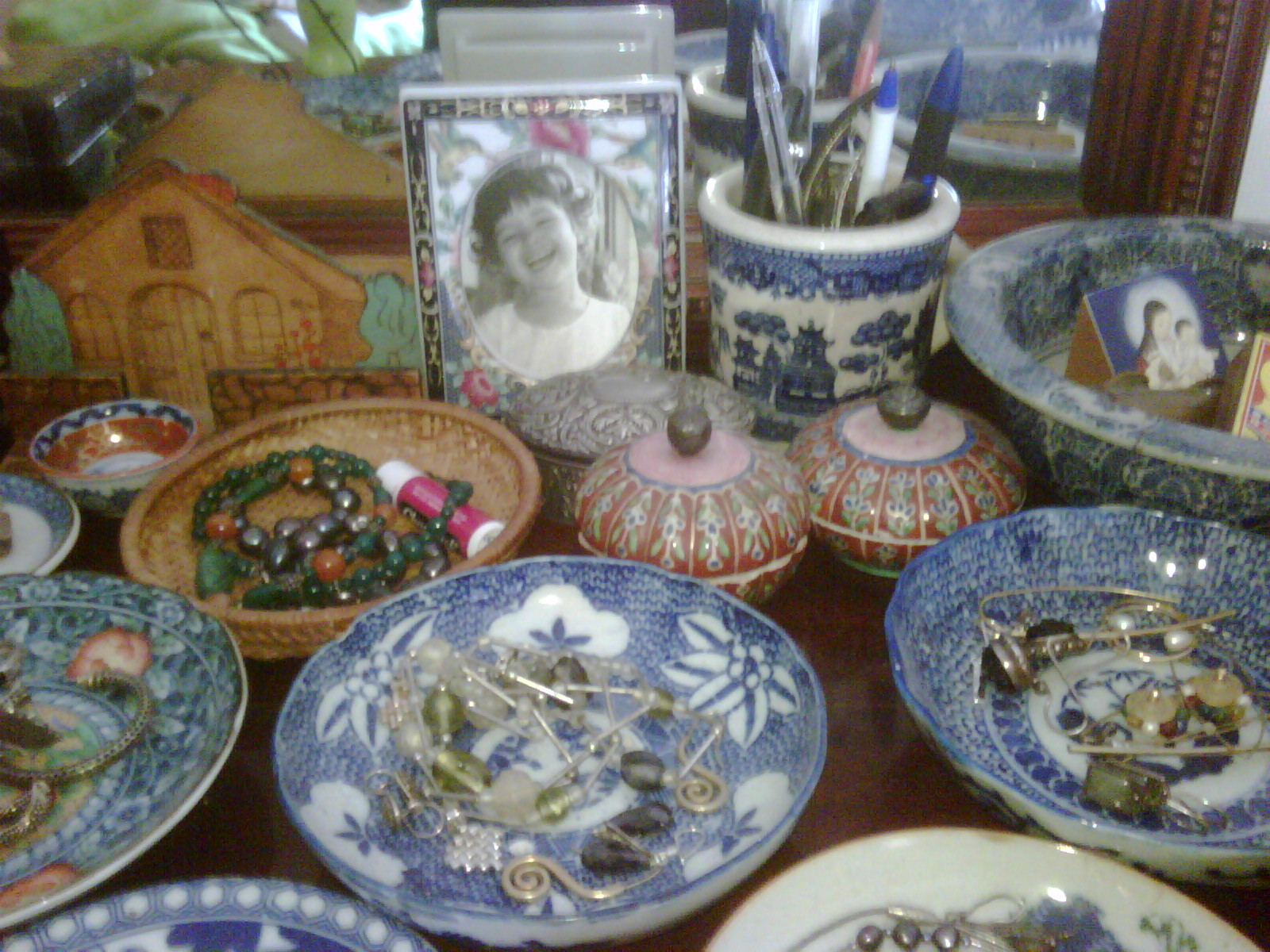
Before the earthquake, I’d been having a great email chat with a reader who collects inban (Japanese transferware), in particular, the chipped, unwanted bargain pieces. She uses them to store her jewelry and other small items, spread across her dresser. This being Japan, she lives in tight quarters, so if something gets knocked off and broken, she doesn’t mind much. I loved the idea of her collection, beloved but a bit broken. Afterwards, I checked with her and none had been destroyed.
At the end of February as well, I found this great Meiji period square platter at the market. It is beautiful, painted in a really rich cobalt with iris and butterfly, but it had a few small firing flaws.
Firing flaws can be caused by many things. Sometimes a piece going into the kiln would touch another item, or a bubble might pop, or some ash would get into the glaze. The detail below shows the flaws up close and they have gotten dirty over time. They will probably wash out, but I don’t really care.
For some, unblemished perfection is the standard but for me, without patina there is no soul, no depth, to an item. I want to see the echoes of wear, of use, of small damages even – perfection is for museum pieces. Most likely as well, perfection is unaffordable. Antiques with flaws make the unaffordable, attainable. And if you had all the money in the world, when would a piece be good enough? The example rare enough? The provenance historic enough? How would you choose what to buy if you did not need that magic intersection of cost and condition?
One of the places this is seen most clearly is in the world of Oriental carpets. My weakness is for worn, almost threadbare rugs. Perhaps it is a kind of sour grapes, as room size antique Persians in great condition tend to start in the serious five figures. By I love the softness of the faded colors and the indescribable quality called patina.
Take Khotan rugs, for example. Often referred to as East Turkestan or Samarkand rugs, they were woven in what is now the eastern-most province of China, long the central crossing of the Silk Road. They are a conglomerate of cultures and history – part Chinese, part Arabic, part Indian, with a European reference. One of the most common, and my favorite, East Turkestan motifs is that of the pomegranate-tree or pomegranate-vase, usually woven in the towns of Kashgar or Yarkand. Surrounded by a series of borders with fretwork, trefoil and cloud patterns, a series of stylized pomegranates grow from a small pot in symmetrical patterns. Most East Turkestan carpets are long and thin, about double length to width, and very large ones (over 12 feet long) are rare and hard to come by. Almost all are old, having been woven no later than about 1940, and most often earlier, and the dyes tend to fade and soften with time.
For a little fun comparison I have assembled a smattering of similarly sized pomegranate East Turkestan examples that fall all along the price and condition spectrum.
“For the uninitiated, Doris Leslie Blau is to rugs what Harry Winston is to jewels—the best,” says designer Carey Maloney in the blog Rural Intelligence. I had to use the quote, as there is no better way to say it. But like Harry Winston, the best is expensive. Doris Leslie Blau has numerous examples like this one, all in the $20-25,000 range.
Not long ago, designer Wendy Haworth featured one in her One Kings Lane sale, half price at around $5000.
Examples can be found on eBay in the $1000-2000 range, although condition can be quite hard to judge. It’s a question of just how threadbare is it?
My pomegranate rug has definite wear to the pile and a few repairs, but the colors are mellow and smooth. I bought it at Chine Gallery on Hollywood Road in Hong Kong eons ago. I was sad to see they didn’t have any on my recent visit. 
Although I did see this large and unusual colored one down the street for sale at Chu’s Fine Arts & Tibetan Antiques.
Rose Anne de Pampelonne used a pomegranate East Turkestan carpet in her living room, a room that like the rug, is a mixture of European and Asian design. More photos of her home can be found here at Elle Decor.
My love of aged rugs is not limited to those from the Samarkand region. I am equal opportunity with Persians, kilims and the like. Designers Roberto Peregalli and Laura Santori Rimini are masters at creating the old world look and faded antique carpets are one of the key components. This room is a perfect blend of Turkish overlay onto its very Englishness, if you know what I mean…
Newer to the game of old world elegance are Olya Thompson and Nathalie Farman-Farma with their new fabric line Tissus Tartares. The two women met and bonded over a love of romantic Russian style, the European Russia of Tolstoy and the Czars, “the rich and sophisticated interplay between East and West as it is found in Russian, Persian and Central Asian designs”.
Featured in Vogue at the beginning of 2010, Thompson’s Brooklyn brownstone captivated me. This February, Farman-Farma’s London home was featured in The World of Interiors and The Wall Street Journal ran an article about their textile line later in the month. While their fabrics are a standout in their interiors, it is the mix with the carpets and the accessories that make the rooms.
The sofa in the photo above and below is covered in their “Ikat” fabric.
Pillows in both homes made from other fabrics in the line including “Jar Ptitsa” and “Eté Muscovite”.
Farman-Farma’s London home features chairs reminiscent of those in Muriel Brandolini’s interiors, a boteh motif (paisley) covered rug and the prettiest sheer curtains.
I believe the lampshade in the corner sports their “Fleur de steppes”. 
The daybed under the window wears “Lemontov”.
The guest room is covered with “Casse-noisette”.
When I first moved to Japan almost seven years ago, I couldn’t help but continue my incessant browsing of the Brooklyn real estate market as if it was important not to lose sight of it. As time went on, I became content with the idea of Japan as my home. One of the unfortunate results of the earthquake is that I have resumed the habit, almost like a nervous tic. Well, lo and behold, Olya Thompson’s Brooklyn Heights townhouse is for sale, first for $5.395 million, but now it has come down to $4.95 million. I wonder if she will throw in the furniture and rugs for that price? It is fun to compare the realtor’s photos with those from the magazines, as they show the utilitarian spaces like the hallways and kitchen. Click here to see the listing.
And speaking of natural disasters, it is always hopeful to read about those who have recovered and rebuilt. Karina Gentinetta and her husband have recreated their New Orleans home from the ground up to look as if it was never damaged. Recovered items that most would have considered destroyed, such as a silver tray, now boast what she calls their “Katrina Patina”. Most impressively, her old world glamour has been achieved on the tightest of budgets. More photos of her lovely home and the great story here.
Gentinetta’s rug is so worn and threadbare, it is actually torn straight up the middle…
Next Day Addendum: Just for counterpoint, I can’t help adding this amazing room by Tom Stringer, featuring the most unusually colored East Turkestan pomegranate-vase rug in a very modern interior. One of the charms of Khotans is that they really can swing either way. Gorgeous!
(N.B. Most of this post was written months ago and then never got published. While some of it is older news, I can’t bear to scrap it as it is all topics that are dear to my heart.)
Image credits: 1. L. Twaronite, 2-3, 7-8. me, 4. Doris Leslie Blau, 5. One Kings Lane, 6. eBay, 9. Elle Decor April 2008, photo credit: Roger Davies, 10. Elle Decor April 2008, photo credit: Roger Davies, 11. Vogue January 2010, 12, 14-15. The Wall Street Journal February 25, 2011, photo credit: Paul Costello, 13, 17, 19, 21. Tissus Tartares, 16, 18, 20. The World of Interiors February 2011, 21. The New York Times April 6, 2011, photo credit: Sara Essex.

